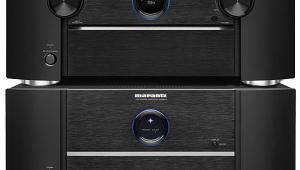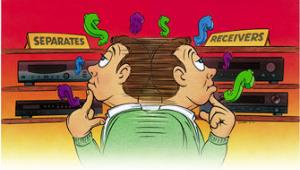I'm looking forward to reading this article about how to write a special occasions essay. It's always challenging to write the perfect speech for a special event and I'm sure this article will provide some great tips.
To Separate or Not to Separate? Page 3
 Closely related to features is the issue of upgradeability. In recent years, the pre/pro category has made great strides toward futureproofing. With competition and the rate of technological advancement being what they are today, people generally aren't willing to spend thousands of dollars on something that will be obsolete within a year. The pre/pro makers have borrowed a bit from the computer industry to accommodate new advances—adopting a modular approach that allows for software upgrades or simple hardware upgrades like replacing a card. Some high-end companies have even instituted trade-in programs that allow you to exchange older gear for new models at a substantial savings—something you're never going to get from a receiver manufacturer.
Closely related to features is the issue of upgradeability. In recent years, the pre/pro category has made great strides toward futureproofing. With competition and the rate of technological advancement being what they are today, people generally aren't willing to spend thousands of dollars on something that will be obsolete within a year. The pre/pro makers have borrowed a bit from the computer industry to accommodate new advances—adopting a modular approach that allows for software upgrades or simple hardware upgrades like replacing a card. Some high-end companies have even instituted trade-in programs that allow you to exchange older gear for new models at a substantial savings—something you're never going to get from a receiver manufacturer.
The high-end receiver market has also incorporated the modular-upgrade approach, leaving less-expensive receivers as the only category without significant futureproofing. Keep in mind that 5.1-channel inputs offer some insulation against obsolescence, and you can add an outboard processor down the road. However, this means adding another box and, oftentimes, substantial extra cost.
If you follow the home theater market, you know that receiver manufacturers take full advantage of their tremendous development, research, and financial resources to introduce new models every year—and they wouldn't mind it a bit if you were to buy an entirely new unit at the same rate. In Japan, this philosophy has almost become part of the buying culture. While some separates manufacturers would certainly follow suit if they could, the bottom line is that separates are usually produced by much smaller companies with more-limited resources, and it usually takes these companies two or three years to develop a new model—even if they choose to make constant model development a high priority. It makes more sense for them (and is far more beneficial to the consumer) to utilize the modular approach and concentrate on offering upgrades for the latest technologies in the short term.
Yet another issue related to features and upgradeability is system flexibility—a quality you naturally see in separates since you're already dealing with multiple components. This is most obvious with power options, considering the flexibility you have with separates to exploit the countless number of amp configurations and upgrade your system as you go. My home theater system, for example, started out long ago with a single five-channel amp, but I now use monoblocks for the front two channels and a five-channel amp for the center and four surround channels. This lets me take advantage of the monoblocks' massive current capabilities for powering large front speakers. Granted, you could do the same thing with a receiver if it has preouts (line-level outputs that allow you to use external amplifiers), but then you've paid for two amp channels (the most expensive element of a receiver) that you're not using. You can also upgrade to a new pre/pro without having to shell out for amplification again, buy a new tuner if a better model comes along, and generally upgrade any separate element of your system without affecting anything else. While more costly up front, the separates approach can end up being more economical over the long haul as a direct result of its overall flexibility.
While separates are more flexible, receivers are undoubtedly easier to deal with and more approachable for most people—and herein lies much of their appeal. With a receiver, you simply hook up your sources, hook up your speakers, and plug it in—then off you go. Separates always require at least five more cables between the pre/pro and amp (that is, until DB-25 takes hold). Also, the more separate components you have, the more configuration and connection your system requires. A receiver, of course, takes up less space, as well—and this is something that many people have to consider. Where receivers don't always hold a significant advantage anymore is in the user-interface category. Many pre/pro makers have ditched the old "let them figure it out" philosophy of the high end and are offering well-thought-out, easily navigable onscreen menu systems, which you'll also find on most receivers. Pre/pros have come a long way in user-friendliness, but the fact is that most people simply find receivers to be easier than separates—easier to buy, easier to place, easier to set up, and easier to use.
I suppose that perception should be brought up in this debate, as well—although it's hardly something that should affect your buying decision. Justified or not, those who are in the know (and many who aren't) will take your system more seriously if it consists of a rack full of separates rather than a one-box receiver. With properly matched speakers, the receiver may run the system just as well, but that doesn't always matter. There are many reasons that the upper echelon of home theater systems—especially dedicated theater environments—employ separates, and not all of those reasons have to do with performance.
So, let's bottom-line this thing. Separates can count pure power, upgradeability, and flexibility on their side, while receivers claim lower initial price, approachability, logistical ease, and features (dollar for dollar). Of course, the real issue is buying the best that your budget will allow. Now, I've cautioned many times before that a more-expensive model isn't necessarily better, and price can be an unreliable barometer in more-direct comparisons. Still, as it relates to overall budget, price is a major factor for almost all of us in the grand scheme of things. The only place I see direct competition between separates and receivers is where they infrequently overlap in price, and this is where the buyer must weigh all the factors relative to the two categories. Outside of this realm, it seems logical to buy separates if you can afford them and a receiver if you can't.
It's no secret that the best audio in the world comes out of separates—as we should expect from amps or preamps that cost tens of thousands of dollars. But there are a lot of receivers out there right now that are doing a fine job of bringing home theater to a lot of people. Whether you're comparing receivers with receivers, separates with receivers, or separates with separates, you'll have to listen and do your homework—that's the only real trick I know to making the right choice. Let your ear, your common sense, and your wallet be your guides through this kinetic period of home theater history. In the A/V world, that trio will almost always pay off in the end.
- Log in or register to post comments
























































